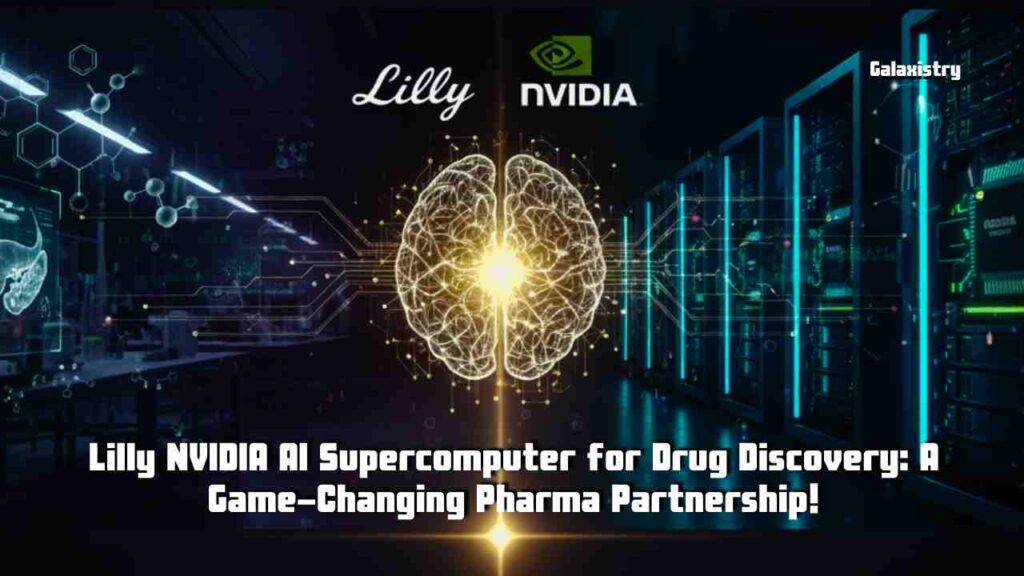Lilly-NVIDIA AI Supercomputer for Drug Discovery: Hello tech friends! The world of Artificial Intelligence (AI) and Machine Learning (ML) isn’t limited to chatbots and image generators. The real revolution is happening behind the scenes, where this technology is tackling some of humanity’s biggest challenges and diseases. In recent days, a groundbreaking news has emerged from the world of AI and Biotech that could change the entire process of drug discovery forever.
America’s leading pharmaceutical company, Eli Lilly has joined hands with the undisputed king of AI, NVIDIA. Their goal? To build the world’s largest pharmaceutical industry-owned AI supercomputer “factory.” This isn’t just a minor upgrade; it’s a billion-dollar bet that will rewrite the future of genomics and personalized medicine.

In this in-depth analysis, we will explain what the Lilly–NVIDIA AI supercomputer deal for drug discovery is, how the supercomputer will work and how it could speed up the discovery of drugs from cancer to Alzheimer’s by 10 times.
Table of Contents
Drug Discovery: The Old “Needle” vs. the New “AI Factory”
To understand why this news is such a big deal, it’s important to first know how medicines are actually made.
Traditional Method (The Old Way): “Needle in a Haystack”
For decades drug discovery has been an extremely slow, expensive and trial-and-error process.
- Finding the target: Scientists spend years identifying which protein is responsible for a disease (like cancer); this is the “lock.”
- Finding the compound: Then in the lab, they test millions of chemical compounds one by one on that protein to see which “key” fits the “lock.”
- Failure: This process takes 10 to 15 years and costs billions of dollars with over 90% of drugs failing in clinical trials.
The new Lilly-NVIDIA AI Supercomputer for Drug Discovery approach:

Lilly’s new AI supercomputer is taking the entire process out of the “lab” and bringing it into “data.” It will function like an AI factory.
This supercomputer will use more than 1,016 of NVIDIA’s latest and most powerful Blackwell Ultra GPUs. That’s so much computational power that it can perform in seconds what would take humans centuries to complete.
How will this supercomputer work? (The “How”)
This supercomputer won’t just store data; it will think using generative AI and foundation models.
1. Training Biomedical Foundation Models:
Just like ChatGPT is trained on internet text, Lilly will train this supercomputer on its proprietary data—worth over $1 billion—including decades of clinical trials, genetic data, protein structures and chemical libraries. This will create an AI model that understands the “language of biology.”
2. In-silico (computer-based) experiments:
Instead of conducting experiments on mice or in a petri dish, scientists will now be able to run experiments in-silico—meaning through computer simulations.
- Example: A scientist could ask the AI, “Design a molecule that binds only to cancer cell protein X, but doesn’t touch healthy cell protein Y.”
- The AI will simulate millions of possibilities and produce the top 10 most promising drug candidates.
3. Digital Twins:
The Lilly–NVIDIA AI supercomputer for drug discovery will also help create digital twins. Using AI models, it can build a “virtual patient” to test how a new drug would affect them—long before it’s ever given to a real human. This will make clinical trials much faster and far safer.
What does it really mean? (The “Why it Matters”)

This deal isn’t just a breakthrough for Lilly—it’s a game-changer for the entire healthcare industry and for patients everywhere.
- Speed: According to NVIDIA CEO Jensen Huang, what once took years can now be done in months or even weeks. AI can detect patterns that humans can’t. It can uncover hidden biomarkers in the vast ocean of genomic data, helping identify which drug will work for which patient.
- Personalized Medicine: Currently a single cancer drug might be given to 100 people but it only works for about 40 of them. The Lilly–NVIDIA AI supercomputer for drug discovery aims to change that. By analyzing your unique genetic makeup, AI can help design a drug made specifically for you.
- Federated Learning: Lilly has also announced an AI platform called Lilly TuneLab, which will use federated learning. This means other biotech companies can use Lilly’s AI models without sharing their proprietary data—promoting innovation while maintaining data privacy.
Conclusion: AI is no longer just a “tool” — it’s a “scientific collaborator”
Lilly’s Chief AI Officer said, “Lilly is moving beyond using AI as just a tool — we’re embracing it as a scientific collaborator.”
The announcement of the Lilly–NVIDIA AI supercomputer for drug discovery is clear proof that the true future of generative AI lies not in consumer tech but in deep science. We are entering an era where AI will not only discover medicines faster but also create drugs that humans could never have imagined.
Also Read: Major Revelation on the Future of Sodium-Ion Battery Technology: Will It Replace Lithium-Ion?
This supercomputer isn’t just a box of silicon and wires; it’s a beacon of hope for new medicines, better treatments and a healthier future for millions.